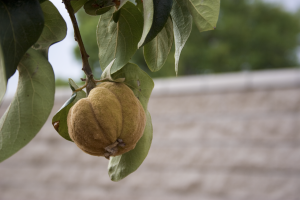Quince is a plant. The seed is used as medicine.
Contents
Uses
The phytochemistry of quince is under study for several possible medical uses.
In subcontinental Indo-Pakistan, quince seeds are known as Bihi Dana. They are used by herbalists for mucus, rashes and ulcerations. A gel prepared from the seeds soaked in water is used for throat and vocal cord inflammation, as well as for skin rashes and allergies.
In Malta, a jam is made from the fruit (ġamm tal-isfarġel). According to local tradition, a teaspoon of the jam dissolved in a cup of boiling water relieves intestinal discomfort.
In Iran and parts of Afghanistan, the quince seeds are collected and boiled and then ingested to combat pneumonia
Benefits
People take quince as a powder, extract, or tea for digestive disorders includingstomach and intestinal pain (gastrointestinal inflammation), as well as diarrhea. Quince is also used for cough.
Some people apply quince directly as a compress or poultice for injuries, swollen and painful joints, nipple soreness, and gashed or deeply cut fingers. A lotion is used to soothe the eyes.
In foods, quince fruit is used to make jam, jelly, marmalade, and pudding. It is also used to make juice and wine.
Cautions
There isn’t enough information to know if quince is safe for medicinal use. The seeds contain cyanide, which suggests that quince seeds might not be safe.
Special Precautions & Warnings:
Pregnancy and breast-feeding: Not enough is known about the use of quince during pregnancy and breast-feeding. Stay on the safe side and avoid use.
Interactions
Medications taken by mouth (Oral drugs) interacts with QUINCE
Quince contains a type of soft fiber called mucilage. Mucilage can decrease how much medicine the body absorbs. Taking quince at the same time you take medications by mouth can decrease the effectiveness of your medication. To prevent this interaction take quince at least one hour after medications you take by mouth.
Other names
Bedana, Cognassier, Coing, Coudonnier, Cydonia oblongata, Cydonia vulgaris, Marmelo, Membrillo, Pommier de Cydon, Pyrus cydonia, Quitte, Quittenbaum
References
Source: WebMD, http://www.webmd.com/vitamins-supplements/ingredientmono-384-quince.aspx?activeingredientid=384&activeingredientname=quince
Wikipedia, https://en.wikipedia.org/wiki/Quince

